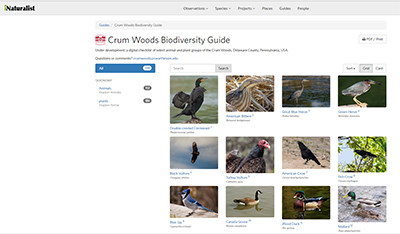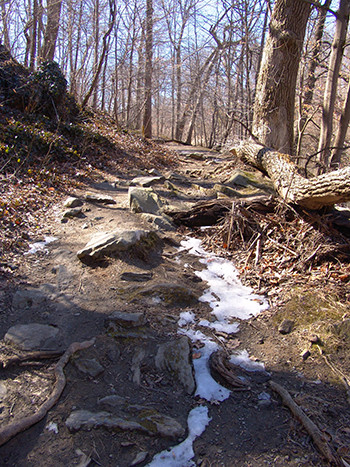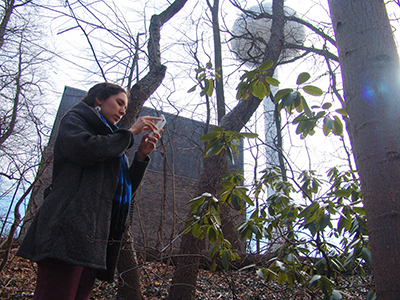
photo by Rick Leche
by Melita Schmeckpeper, 2017-2018 Education Intern
The Crum Woods is home to a diverse group of plants and animals, but to many visitors the identities of these species is often a mystery. While field guides are great for learning new species, you may not have one on hand right when you need it the most— many birders and naturalists have had the frustrating experience of watching an interesting but mysterious bird fly off into the distance unidentified.

A Crum Woods biodiversity guide can be found in iNaturalist.
Luckily, a new project orchestrated by Swarthmore professor and Crum Woods Stewardship Committee co-chair Liz Nichols aims to make it easier for anyone with a smartphone to learn about what lives in Crum Woods. Using iNaturalist, an app and website that functions as a social network for citizen scientists, Liz and her students are in the process of developing an easily-accessible guide to the plant and animal diversity of the woods. Their Crum Woods Biodiversity Guide, which currently lists the woods’ bird and plant species, can be found on iNaturalist here.
iNaturalist allows people to share their observations of wild species, help each other with identification, and participate in larger projects that gather useful data for a variety of biodiversity-related research projects. By installing the app on your smartphone, you can access the Crum Woods Biodiversity Guide on your phone, record your own observations, and share your findings with others. For those who prefer not to use a smartphone while exploring the woods, the guide can also be printed in a variety of convenient formats.

This time of year, the Crum Woods is home to a variety of birds including woodpeckers, hawks, and owls. photo credit: R. Robert
This time of year, the Crum Woods is home to a variety of birds including woodpeckers, hawks, and owls. Stop by the trailheads or arboretum office to pick up a flyer that lists the woods’ winter species and gives instructions for accessing iNaturalist. Trail maps are also available.
While enjoying some birdwatching can be a great way to brighten up a winter walk, be sure to check back in the spring as well: many migrating bird species will arrive as the weather warms. Overall, the Crum Woods is home to over 140 bird species. Spring and summer will also be a great time to use iNaturalist to help you learn more about the woods’ plant species, which are also included in the new Biodiversity Guide.
So how did the new Biodiversity Guide come into being? In the past, Scott Arboretum has had printed checklists available for birdwatchers. When it came time to update these lists, Professor Liz Nichols suggested that moving them to iNaturalist would be a great way to make them more interactive, accessible, and easy to update. She recruited two students from her conservation biology class who were familiar with iNaturalist, Amanda Carrillo-Perez ‘19 and Natalie LaScala ‘19, to build the guide. In the past, creating a checklist complete with images and species descriptions would be a lengthy endeavor. Now, instead of basically writing their own field guide, Amanda and Natalie could draw on iNaturalist’s access to vetted open source images and text. Impressively, they finished the Crum Woods bird guide in a few days, and immediately moved on to creating a guide to the woods’ vascular plants.

Using iNaturalist, you can identify plants while out on a hike in the Crum Woods. photo credit: R. Robert
Last spring, Liz tested using iNaturalist to increase students’ interaction with the woods by including it in activities in her conservation biology class. It was also used by an introductory biology course taken by over a hundred first-year students. According to Liz, this helped raise campus enthusiasm about iNaturalist and the Crum Woods, and she hopes to continue to build on this interest.
Considering how important public enthusiasm is to conservation efforts locally and internationally, iNaturalist not only represents a way to make learning about local flora and fauna easier and more fun, but also serves as a way to emphasize the importance of protecting places like the Crum Woods. By helping us see the woods in greater detail, iNaturalist and the new Crum Woods Biodiversity Guide demonstrate how complex and wonderful this 220 acre section of Swarthmore’s campus truly is.
_____________________________________________________________________________________________________________________________________
This article is part of an ongoing column called the Crum Woods Chronicle. The Crum Woods Chronicle will be periodic updates and observations about subjects related to natural history, interesting species found in and around the Crum Woods, and exciting events you can get involved in. My hope is that some of these topics will interest you, strengthen your connection to the Crum Woods, and inspire you to explore your backyard a little more often.
Natural areas do not maintain their character and quality independently, especially when they are heavily used by people and embedded in urban environments. Educating yourself about aspects of the Crum Woods that interest you and understanding how your individual use of the Crum Woods impacts it (and how you can reduce that impact!) are important steps every one of us should take.
“In the end we will conserve only what we love; we will love only what we understand; and we will understand only what we are taught.” –Baba Dioum
